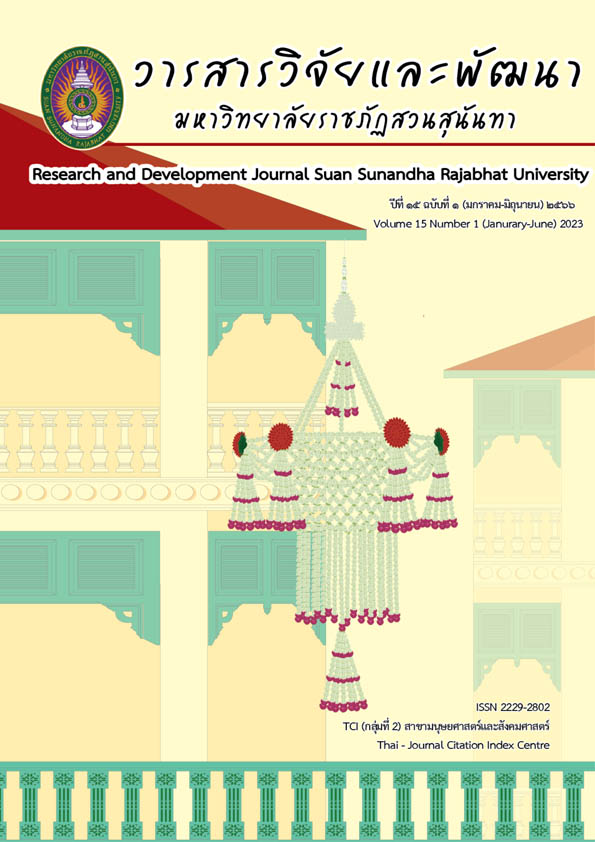ปัจจัยที่มีความสัมพันธ์กับประสิทธิภาพการเรียนรู้ ด้านการเรียนของนักศึกษาพยาบาล
คำสำคัญ:
ความสุข, เทคนิคการสร้างความสุข, ประสิทธิภาพการเรียนรู้ด้านการเรียน, ความสุข, เทคนิคนักศึกษาพยาบาลบทคัดย่อ
การมีประสิทธิภาพด้านการเรียนรู้นำมาซึ่งการพัฒนาสติปัญญาสามารถนำไปประยุกต์ใช้ได้อย่างเหมาะสมกับทุกสถานการณ์ การวิจัยแบบสำรวจภาคตัดขวางนี้ มีวัตถุประสงค์เพื่อศึกษาประสิทธิภาพการเรียนรู้ ด้านการเรียน และปัจจัยที่มีความสัมพันธ์กับประสิทธิภาพการเรียนรู้ด้านการเรียนของนักศึกษาพยาบาล กลุ่มตัวอย่างนักศึกษาพยาบาล 260 ราย ใช้วิธีการสุ่มอย่างง่ายจากนักศึกษาพยาบาลทุกชั้นปี เก็บรวบรวมข้อมูลด้วยแบบประเมินความสุข และแบบสอบถามที่ผู้วิจัยสร้างขึ้น มีค่าความเชื่อมั่น ดังนี้ ประสิทธิภาพการเรียนรู้ด้านการเรียน .956 ความสุข .891 และเทคนิคการสร้างความสุข .966 วิเคราะห์ข้อมูลด้วยสถิติเชิงพรรณนา การทดสอบแบบไคสแควร์ และสัมประสิทธิ์สหสัมพันธ์แบบเพียร์สัน
ผลการวิจัย พบว่า กลุ่มตัวอย่างนักศึกษาพยาบาลส่วนใหญ่ (ร้อยละ 90.0) เป็นเพศหญิง มีอายุระหว่าง 20 – 24 ปี (ร้อยละ 74.2) มีประสิทธิภาพการเรียนรู้ด้านการเรียนโดยรวมเหมาะสม ร้อยละ 48.5 ส่วนรายด้าน พบว่า เหมาะสม 2 ด้าน ได้แก่ มนุษยสัมพันธ์ (ร้อยละ 67.3) แนวทางการปฏิบัติงาน (ร้อยละ 47.7) ความรู้ด้านวิชาการ พบระดับปานกลาง (ร้อยละ 50.4)
ปัจจัยที่มีความสัมพันธ์ทางบวกอย่างมีนัยสำคัญทางสถิติ (p<.01) กับประสิทธิภาพการเรียนรู้ด้านการเรียนโดยรวม คือ ชั้นปีที่ศึกษา (r=.222) ความสุข (r=.279) และเทคนิคการสร้างความสุข (r=.423) ส่วน เพศ อายุ และค่าใช้จ่ายที่ได้รับต่อเดือนไม่มีความสัมพันธ์ทางสถิติ (p>.05)
เอกสารอ้างอิง
Al-Ani, M. S. (2019). Happiness Measurement through Classroom Based on Face Tracking. UHD Journal of Science and Technology, 3(1), 9-18.
Bloom, B. S. (1979). Toxonomy of Educational Objectives: The Classification of Educational Goals. Handbook/ Cognitive Domain. USA: Longman Inc.
Bundasak, T., Chaowiang, K., & Jangasem, N. (2017). Happily Learning among Nursing Students. Journal of MUC Peace Studies, 5(1), 357-369 (In Thai).
College of Nursing and Health, Suan Sunandha Rajabhat University. (2020). Philosophy Course. Retrieved from https://ssru.ac.th/education_college-nurse.php
Ebenuwa-Okoh, E. E. (2010). Influence of Age, Financial Status, and Gender on Academic Performance among Undergraduates. Journal of Psychology, 1(2), 99-103.
Janepanish Visudtibhan, P., & Disorntatiwat, P. (2015). Learning Style Preferences of Nursing Students at Ramathibodi School of Nursing, Faculty of Medicine, Ramathibodi Hospital, Mahidol University. Nursing Journal of Ministry of Public Health, 4, 70-82 (In Thai).
Junsai, B., & Chareontanawit, P. (2010). Evaluation on the Effectiveness of the Practicum of Students from the Faculty of Science and Technology. Academic Services Journal, 21(1), 110-137 (In Thai).
Kraithaworn, P., & Kittipimpanon, K. (2014). The Relationship among Sense of University Belonging, Happiness in Learning, Learning-Facilitating Environment and Academic Achievement among Undergraduate Nursing Science Students. Ramathibodi Nursing Journal, 20(3), 415-429 (In Thai).
Kunaviktikul, W. (2015). Teaching and Learning in the discipline of nursing in the 21st century. Nursing Journal, 42(2), 152-156 (In Thai).
Lokawit, K. (2011). Time Management Ability of Nursing Students in Pathumthani University. Academic Journal of Pathumthani University, 3(1), 27-36 (In Thai).
Muijeen, K. (2016). Creating Happiness with Positive Psychology. Science and Technology Journal, 24(4), 673-681 (In Thai).
Na Nakorn, C., & Bunlikitkul, T. (2013). Ability in caring for clients with wounds among 2nd year nursing students in The Practicum of The Fundamentals of Nursing. The Thai Red Cross College of Nursing, 6(1), 34-47 (In Thai).
Pasunon, P. (2014). Sample Size Determination from Krejcie and Morgan (1970) Approach in Quantitative Research. The Journal of Faculty of Applied Arts, 2, 112-120 (In Thai).
Punsumreang, T., & Klin-ual, A. (2001). The teaching and learning’s conditions that promoting critical thinking of the nursing students of Bhoromrajchanok Institute, Central areas, Ministry of Public Health. Retrieved from http://www.bcnpb.ac.th/vijai2544.htm (In Thai)
Rafi, F., Maryam, S., & Parvizy, S. (2019). Academic Motivation in Nursing Students: A Hybrid Concept Analysis. Iranian journal of nursing midwifery research, 24(5), 315-322.
Sheikhaboumasoudi, R., Bagheri, M., Hossein, S. A., Ashouri, E., & Elahi, N. (2018). Improving Nursing Students' Learning Outcomes in Fundamentals of Nursing Course through Combination of Traditional and e-Learning Methods. Iranian journal of nursing midwifery research, 23(3), 217-221.
Shuaytong, P., Suphan, B., Sirimongkhon, S., Karuhadej, P., & Cherwanitchakorn, S. (2014). Personal, Family and Social Factors Related to Happiness of the Elderly in Srisaket Province. In: Yodshim S. The 1st National Academic Suan Sunandha Meeting. Rattanakosin Art to Develop Local Thai (pp. 435-449). Bangkok: Suan Sunandha Rajapaht University (In Thai) .
Shunhashavee, A. (2002). Teaching for Successful Intelligence to Increase Student Learning and Achievement. . Bangkok: Pearson Education Indochina Ltd (In Thai) .
UNESCO Asia-Pacific Education Thematic Brief. (2017). Promoting Learner, Happiness and Well-being. Retrieved from https://bangkok.unesco.org/sites/default/files/assets/article/
Education/files/thematicbriefhappyschools.pdf
Vageethongrattana, P. (2005). The Influence of Learning Efficiency toward Job Performance Effectiveness on Accountants in Nakhonratchasima Province. Journal of the Association of Researchers, 20(1), 85-94 (In Thai).
Zaker, A., Dadsetan, A., Nasiri, Z., Azimi, S., & Rahnama, F. (2016). Effectiveness of Happiness on Self-efficacy of Students. Electronic Journal of Biology, 12(4), 333-336.
ดาวน์โหลด
เผยแพร่แล้ว
รูปแบบการอ้างอิง
ฉบับ
ประเภทบทความ
สัญญาอนุญาต
ลิขสิทธิ์ (c) 2023 มหาวิทยาลัยราชภัฏสวนสุนันทา

อนุญาตภายใต้เงื่อนไข Creative Commons Attribution-NonCommercial-NoDerivatives 4.0 International License.
บทความที่ได้รับการตีพิมพ์เป็นลิขสิทธิ์ของ สถาบันวิจัยและพัฒนา มหาวิทยาลัยราชภัฎสวนสุนันทา
ข้อความที่ปรากฏในบทความแต่ละเรื่องในวารสารวิชาการเล่มนี้เป็นความคิดเห็นส่วนตัวของผู้เขียนแต่ละท่านไม่เกี่ยวข้องกับมหาวิทยาลัยราชภัฎสวนสุนันทา และคณาจารย์ท่านอื่นๆในมหาวิทยาลัยฯ แต่อย่างใด ความรับผิดชอบองค์ประกอบทั้งหมดของบทความแต่ละเรื่องเป็นของผู้เขียนแต่ละท่าน หากมีความผิดพลาดใดๆ ผู้เขียนแต่ละท่านจะรับผิดชอบบทความของตนเองแต่ผู้เดียว





